Optical Bottle Shaping Using Axicons with Amplitude or Phase Apodization
Abstract
:1. Introduction
2. Theoretical Foundations and Modeling
2.1. Axial Distribution Control by Amplitude Apodization of the Axicon
2.1.1. Formation of an Axial Light Segment Using an Annular Slot
2.1.2. Formation of an Optical Bottle when Applying an Annular Blocking Screen
2.2. Formation of Optical Bottles by Phase Apodization of Axicons
2.2.1. Formation of an Optical Bottle Due to Axicons with Phase apodization
2.2.2. Formation of a Set of Optical Bottles Due to Phase Jumps on the Axicon
3. Experimental Results
4. Conclusions
Supplementary Materials
Author Contributions
Funding
Institutional Review Board Statement
Informed Consent Statement
Data Availability Statement
Acknowledgments
Conflicts of Interest
References
- Ashkin, A.; Dziedzic, J.M.; Bjorkholm, J.E.; Chu, S. Observation of a Single-Beam Gradient Force Optical Trap for Dielectric Particles. Opt. Lett. 1986, 11, 288–290. [Google Scholar] [CrossRef] [PubMed]
- Ashkin, A.; Dziedzic, J.M.; Yamane, T. Optical Trapping and Manipulation of Single Cells Using Infrared Laser Beams. Nature 1987, 330, 769–771. [Google Scholar] [CrossRef] [PubMed]
- LaFratta, C.N. Optical Tweezers for Medical Diagnostics. Anal. Bioanal. Chem. 2013, 405, 5671–5677. [Google Scholar] [CrossRef] [PubMed]
- Hu, S.; Liao, Z.W.; Cai, L.; Jiang, X.X. Near-Field Optical Tweezers for Chemistry and Biology. Phys. Status Solidi A 2020, 217, 1900604. [Google Scholar] [CrossRef]
- Metcalf, H.J.; van der Straten, P. Laser Cooling and Trapping; Springer: New York, NY, USA, 1999; pp. 149–164. [Google Scholar]
- Bustamante, C.J.; Chemla, Y.R.; Liu, S.; Wang, M.D. Optical Tweezers in Single-Molecule Biophysics. Nat. Rev. Methods Prim. 2021, 1, 25. [Google Scholar] [CrossRef]
- Wang, M.D.; Yin, H.; Landick, R.; Gellse, J.; Block, S.M. Stretching DNA with Optical Tweezers. Biophys. J. 1997, 72, 1335–1346. [Google Scholar] [CrossRef]
- Zhong, M.-C.; Wei, X.-B.; Zhou, J.-H.; Wang, Z.-Q.; Li, Y.-M. Trapping Red Blood Cells in Living Animals Using Optical Tweezers. Nat. Commun. 2013, 4, 1768. [Google Scholar] [CrossRef]
- Chu, S.; Bjorkholm, J.E.; Ashkin, A.; Cable, A. Experimental Observation of Optically Trapped Atoms. Phys. Rev. Lett. 1986, 57, 314–317. [Google Scholar] [CrossRef]
- Dufresne, E.R.; Grier, D.G. Optical Tweezer Arrays and Optical Substrates Created with Diffractive Optical Elements. Rev. Sci. Instrum. 1998, 69, 1974–1977. [Google Scholar] [CrossRef]
- Curtis, J.E.; Koss, B.A.; Grier, D.G. Dynamic Holographic Optical Tweezers. Opt. Commun. 2002, 207, 169–175. [Google Scholar] [CrossRef]
- Forbes, A. Structured Light. Nat. Photon. 2021, 15, 253–262. [Google Scholar] [CrossRef]
- Arlt, J. Generation of a beam with a dark focus surrounded by regions of higher intensity: The optical bottle beam. Opt. Lett. 2000, 25, 191–193. [Google Scholar] [CrossRef]
- Yelin, D.; Bouma, B.E.; Tearney, G.J. Generating an adjustable three-dimensional dark focus. Opt. Lett. 2004, 29, 661–663. [Google Scholar] [CrossRef]
- Xiao, Y.; Yu, Z.; Wambold, R.A.; Mei, H.; Hickman, G.; Goldsmith, R.H.; Saffman, M.; Kats, M.A. Efficient generation of optical bottle beams. Nanophotonics 2021, 10, 2893–2901. [Google Scholar] [CrossRef]
- Shvedov, V.G.; Hnatovsky, C.; Rode, A.V.; Krolikowski, W. Robust trapping and manipulation of airborne particles with a bottle beam. Opt. Express 2011, 19, 17350–17356. [Google Scholar] [CrossRef]
- Alpmann, C.; Esseling, M.; Rose, P.; Denz, C. Holographic optical bottle beams. Appl. Phys. Lett. 2012, 100, 111101. [Google Scholar] [CrossRef]
- Gong, Z.; Pan, Y.-L.; Videen, G.; Wang, C. Optical trapping and manipulation of single particles in air: Principles, technical details, and applications. J. Quant. Spectrosc. Radiat. Transf. 2018, 214, 94–119. [Google Scholar] [CrossRef]
- Chaloupka, J.L.; Fisher, Y.; Kessler, T.J.; Meyerhofer, D.D. Single-beam, ponderomotive-optical trap for free electrons and neutral atoms. Opt. Lett. 1997, 22, 1021–1023. [Google Scholar] [CrossRef]
- Porfirev, A.P.; Skidanov, R.V. Generation of an array of optical bottle beams using a superposition of Bessel beams. Appl. Opt. 2013, 52, 6230–6238. [Google Scholar] [CrossRef]
- Cai, Y.; Lu, X.; Lin, Q. Hollow Gaussian Beams and Their Propagation Properties. Opt. Lett. 2003, 28, 1084–1086. [Google Scholar] [CrossRef]
- Wei, C.; Lu, X.; Wu, G.; Wang, F.; Cai, Y. A New Method for Generating a Hollow Gaussian Beam. Appl. Phys. B 2014, 115, 55–60. [Google Scholar] [CrossRef]
- Liu, Z.; Zhao, H.; Liu, J.; Lin, J.; Ahmad, M.A.; Liu, S. Generation of Hollow Gaussian Beams by Spatial Filtering. Opt. Lett. 2007, 32, 2076–2078. [Google Scholar] [CrossRef] [PubMed]
- Lu, L.; Wang, Z. Hollow Gaussian Beam: Generation, Transformation and Application in Optical Limiting. Opt. Commun. 2020, 471, 125809. [Google Scholar] [CrossRef]
- Ozeri, R.; Khaykovich, L.; Davidson, N. Long spin relaxation times in a single-beam blue-detuned optical trap. Phys. Rev. A 1999, 59, R1750–R1753. [Google Scholar] [CrossRef]
- Xia, M.; Wang, Z.; Yin, Y.; Zhou, Q.; Xia, Y.; Yin, J. Generation and Propagation Characteristics of a Localized Hollow Beam. Laser Phys. 2018, 28, 55001. [Google Scholar] [CrossRef]
- Philip, G.M.; Viswanathan, N.K. Generation of Tunable Chain of Three-Dimensional Optical Bottle Beams via Focused Multi-Ring Hollow Gaussian Beam. J. Opt. Soc. Am. A 2010, 27, 2394–2401. [Google Scholar] [CrossRef]
- Chremmos, I.; Zhang, P.; Prakash, J.; Efremidis, N.K.; Christodoulides, D.N.; Chen, Z. Fourier-space generation of abruptly autofocusing beams and optical bottle beams. Opt. Lett. 2011, 36, 3675–3677. [Google Scholar] [CrossRef]
- Chremmos, I.D.; Chen, Z.; Christodoulides, D.N.; Efremidis, N.K. Abruptly autofocusing and autodefocusing optical beams with arbitrary caustics. Phys. Rev. A 2012, 85, 23828. [Google Scholar] [CrossRef]
- Qian, Y.; Lai, S.; Mao, H. Generation of high-power bottle beams and autofocusing beams. IEEE Photon. J. 2018, 10, 6500607. [Google Scholar] [CrossRef]
- Ye, H.; Wan, C.; Huang, K.; Han, T.; Teng, J.; Ping, Y.S.; Qiu, C.W. Creation of Vectorial Bottle-Hollow Beam Using Radially or Azimuthally Polarized Light. Opt. Lett. 2014, 39, 630–633. [Google Scholar] [CrossRef]
- Shvedov, V.G.; Hnatovsky, C.; Shostka, N.; Krolikowski, W. Generation of Vector Bottle Beams with a Uniaxial Crystal. J. Opt. Soc. Am. B 2013, 30, 1–6. [Google Scholar] [CrossRef]
- Gerchberg, R.W.; Saxton, W.O. A practical algorithm for the determination of phase from image and diffraction plane pictures. Optik 1972, 35, 237–246. [Google Scholar]
- Kotlyar, V.V.; Khonina, S.N.; Soifer, V.A. Iterative calculation of diffractive optical elements focusing into a three dimensional domain and the surface of the body of rotation. J. Mod. Opt. 1996, 43, 1509–1524. [Google Scholar] [CrossRef]
- Zhang, J.; Pegard, N.; Zhong, J.; Adesnik, H.; Waller, L. 3D computer-generated holography by non-convex optimization. Optica 2017, 4, 1306–1313. [Google Scholar] [CrossRef]
- Kachalov, D.G.; Gamazkov, K.A.; Pavelyev, V.S.; Khonina, S.N. Optimization of binary DOE for formation of the “Light Bottle”. Comput. Opt. 2011, 35, 70–76. [Google Scholar]
- Pavelyev, V.; Osipov, V.; Kachalov, D.; Khonina, S.; Cheng, W.; Gaidukeviciute, A.; Chichkov, B. Diffractive optical elements for the formation of “light bottle” intensity distributions. Appl. Opt. 2012, 51, 4215–4218. [Google Scholar] [CrossRef]
- Turpin, A.; Shvedov, V.; Hnatovsky, C.; Loiko, Y.V.; Mompart, J.; Krolikowski, W. Optical vault: A reconfigurable bottle beam based on conical refraction of light. Opt. Express 2013, 21, 26335–26340. [Google Scholar] [CrossRef]
- Zhang, P.; Zhang, Z.; Prakash, J.; Huang, S.; Hernandez, D.; Salazar, M.; Christodoulides, D.N.; Chen, Z. Trapping and transporting aerosols with a single optical bottle beam generated by moiré techniques. Opt. Lett. 2011, 36, 1491–1493. [Google Scholar] [CrossRef]
- de Angelis, M.; Cacciapuoti, L.; Pierattini, G.; Tino, G.M. Axially symmetric hollow beams using refractive conical lenses. Opt. Lasers Eng. 2003, 39, 283–291. [Google Scholar] [CrossRef]
- Wei, M.-D.; Shiao, W.-L.; Lin, Y.-T. Adjustable generation of bottle and hollow beams using an axicon. Opt. Commun. 2005, 248, 7–14. [Google Scholar] [CrossRef]
- Lin, J.H.; Wei, M.D.; Liang, H.H.; Lin, K.H.; Hsieh, W.F. Generation of supercontinuum bottle beam using an axicon. Opt. Express 2007, 15, 2940–2946. [Google Scholar] [CrossRef] [PubMed]
- Zeng, X.; Wu, F. The analytical description and experiments of the optical bottle generated by an axicon and a lens. J. Mod. Opt. 2008, 55, 3071–3081. [Google Scholar] [CrossRef]
- Khonina, S.N.; Porfirev, A.P. 3D transformations of light fields in the focal region implemented by diffractive axicons. Appl. Phys. B 2018, 124, 191. [Google Scholar] [CrossRef]
- Khonina, S.N.; Porfirev, A.P.; Volotovskiy, S.G.; Ustinov, A.V.; Fomchenkov, S.A.; Pavelyev, V.S.; Schröter, S.; Duparré, M. Generation of multiple vector optical bottle beams. Photonics 2021, 8, 218. [Google Scholar] [CrossRef]
- Daria, V.R.; Rodrigo, P.J.; Glückstad, J. Dynamic array of dark optical traps. Appl. Phys. Lett. 2004, 84, 323–325. [Google Scholar] [CrossRef]
- Mcleod, J.H. The Axicon: A New Type of Optical Element. J. Opt. Soc. Am. 1954, 44, 592–597. [Google Scholar] [CrossRef]
- Khonina, S.N.; Kazanskiy, N.L.; Khorin, P.A.; Butt, M.A. Modern Types of Axicons: New Functions and Applications. Sensors 2021, 21, 6690. [Google Scholar] [CrossRef]
- Akturk, S.; Arnold, C.L.; Prade, B.; Mysyrowicz, A. Generation of high quality tunable Bessel beams using a liquid-immersion axicon. Opt. Commun. 2009, 282, 3206–3209. [Google Scholar] [CrossRef]
- Khonina, S.N.; Kazanskiy, N.L.; Karpeev, S.V.; Butt, M.A. Bessel Beam: Significance and Applications—A Progressive Review. Micromachines 2020, 11, 997. [Google Scholar] [CrossRef]
- Garces-Chavez, V.; McGloin, D.; Melville, H.; Sibbett, W.; Dholakia, K. Simultaneous micromanipulation in multiple planes using a self-resonstructing light beam. Nature 2002, 419, 145–147. [Google Scholar] [CrossRef]
- Gori, F.; Guattari, G.; Padovani, C. Bessel-Gauss beams. Opt. Commun. 1987, 64, 491–495. [Google Scholar] [CrossRef]
- Krasin, G.K.; Vinogradov, M.A.; Kovalev, M.S.; Nosov, P.A. Investigation of parameters of the Bessel beam formed by an axicon. Proc. SPIE 2019, 11028, 110281Q. [Google Scholar] [CrossRef]
- Stsepuro, N.; Nosov, P.; Galkin, M.; Krasin, G.; Kovalev, M.; Kudryashov, S. Generating Bessel-Gaussian Beams with Controlled Axial Intensity Distribution. Appl. Sci. 2020, 10, 7911. [Google Scholar] [CrossRef]
- Gorelick, S.; Paganin, D.M.; Korneev, D.; De Marco, A. Hybrid refractive-diffractive axicons for Bessel-beam multiplexing and resolution improvement. Opt. Express 2020, 28, 12174–12188. [Google Scholar] [CrossRef]
- Monsoriu, J.A.; Furlan, W.D.; Andrés, P.; Lancis, J. Fractal conical lenses. Opt. Express 2006, 14, 9077–9082. [Google Scholar] [CrossRef]
- Mihailescu, M.; Preda, A.M.; Sobetkii, A.; Petcu, A.C. Fractal-like diffractive arrangement with multiple focal points. Opto-Electron. Rev. 2009, 17, 330–337. [Google Scholar] [CrossRef]
- Zhu, L.; Yu, J.; Zhang, D.; Sun, M.; Chen, J. Multifocal spot array generated by fractional Talbot effect phase-only modulation. Opt. Express 2014, 22, 9798–9808. [Google Scholar] [CrossRef]
- Khonina, S.N.; Volotovsky, S.G. Fractal cylindrical fracxicon. Opt. Mem. Neural Netw. 2018, 27, 1–9. [Google Scholar] [CrossRef]
- Rastani, K.; Marrakchi, A.; Habiby, S.F.; Hubbard, W.M.; Gilchrist, H.; Nahory, R.E. Binary phase Fresnel lenses for generation of two-dimensional beam arrays. Appl. Opt. 1991, 30, 1347–1354. [Google Scholar] [CrossRef]
- Khonina, S.N.; Ustinov, A.V.; Skidanov, R.V.; Porfirev, A.P. Local foci of a parabolic binary diffraction lens. Appl. Opt. 2015, 54, 5680–5685. [Google Scholar] [CrossRef]
- Davis, J.A.; Moreno, I.; Martinez, J.L.; Hernandez, T.J.; Cottrell, D.M. Creating three-dimensional lattice patterns using programmable Dammann gratings. Appl. Opt. 2011, 50, 3653–3657. [Google Scholar] [CrossRef] [PubMed]
- Zhu, L.; Sun, M.; Zhu, M.; Chen, J.; Gao, X.; Ma, W.; Zhang, D. Three-dimensional shape-controllable focal spot array created by focusing vortex beams modulated by multi-value pure-phase grating. Opt. Express 2014, 22, 21354–21367. [Google Scholar] [CrossRef] [PubMed]
- Khonina, S.N.; Porfirev, A.P.; Ustinov, A.V. Sudden autofocusing of superlinear chirp beams. J. Opt. 2018, 20, 25605. [Google Scholar] [CrossRef]
- Friberg, A.T. Stationary-phase analysis of generalized axicons. J. Opt. Soc. Am. A 1996, 13, 743–750. [Google Scholar] [CrossRef]
- Ustinov, A.V.; Khonina, S.N. Generalized lens: Calculation of distribution on the optical axis. Comput. Opt. 2013, 37, 307–315. [Google Scholar] [CrossRef]
- Porfirev, A.P.; Dubman, A.B.; Porfiriev, D.P. Demonstration of a simple technique for controllable revolution of light-absorbing particles in air. Opt. Lett. 2020, 45, 1475–1478. [Google Scholar] [CrossRef]

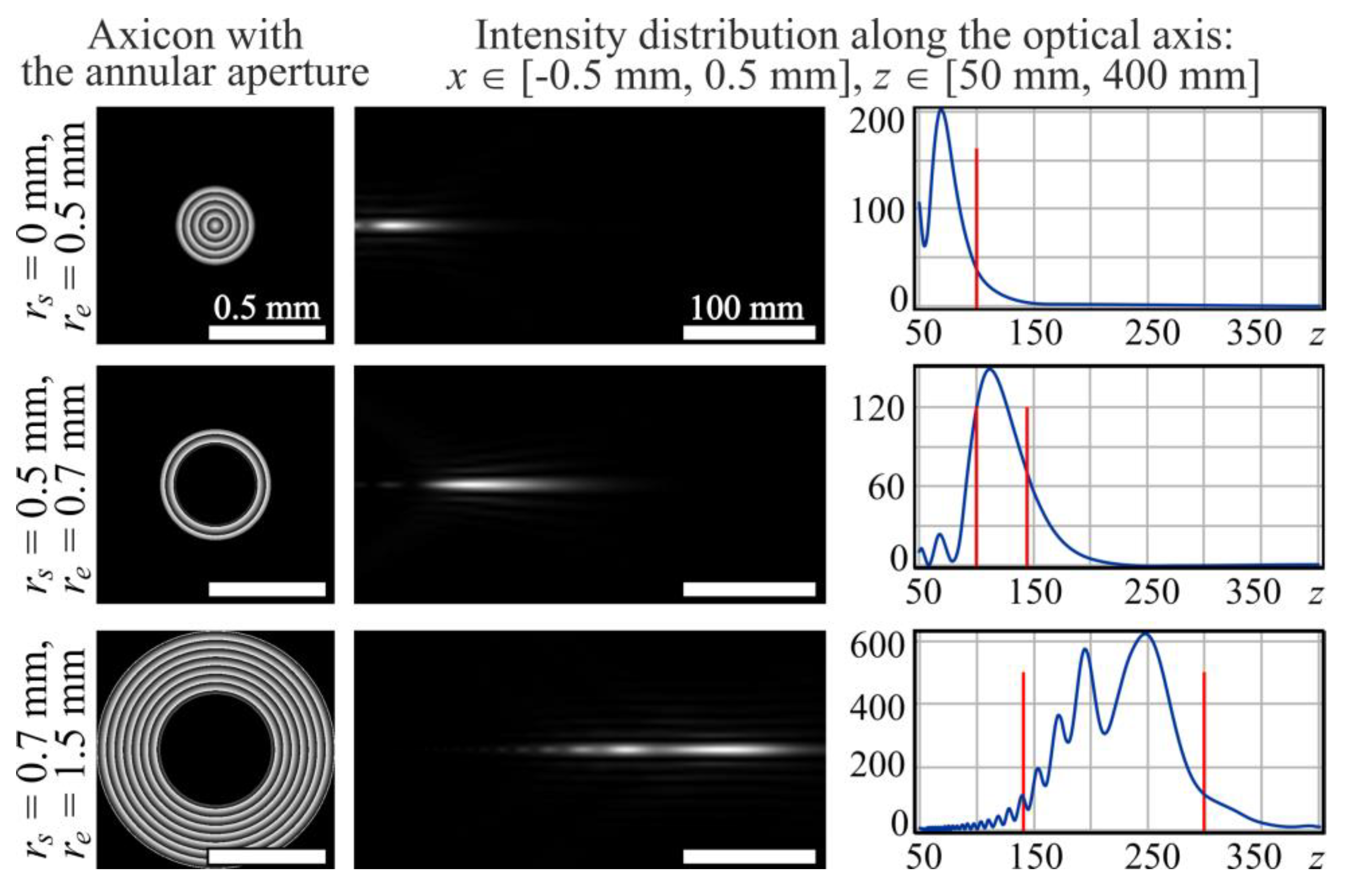
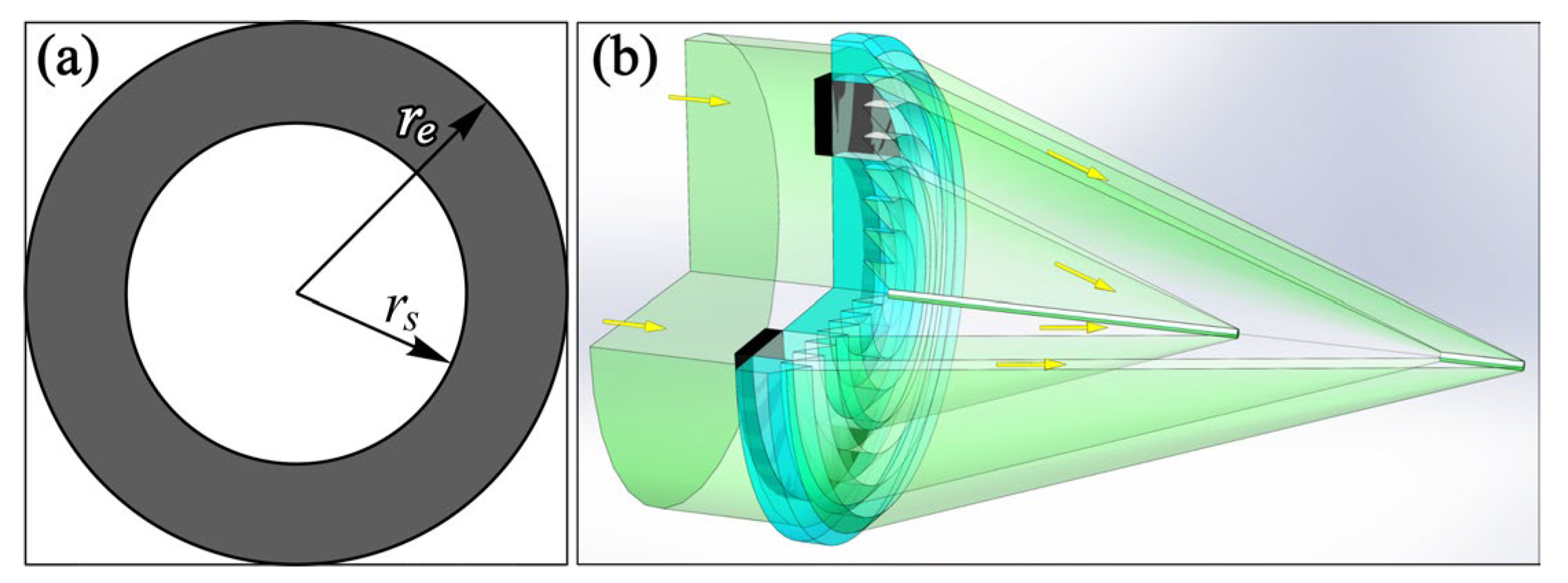

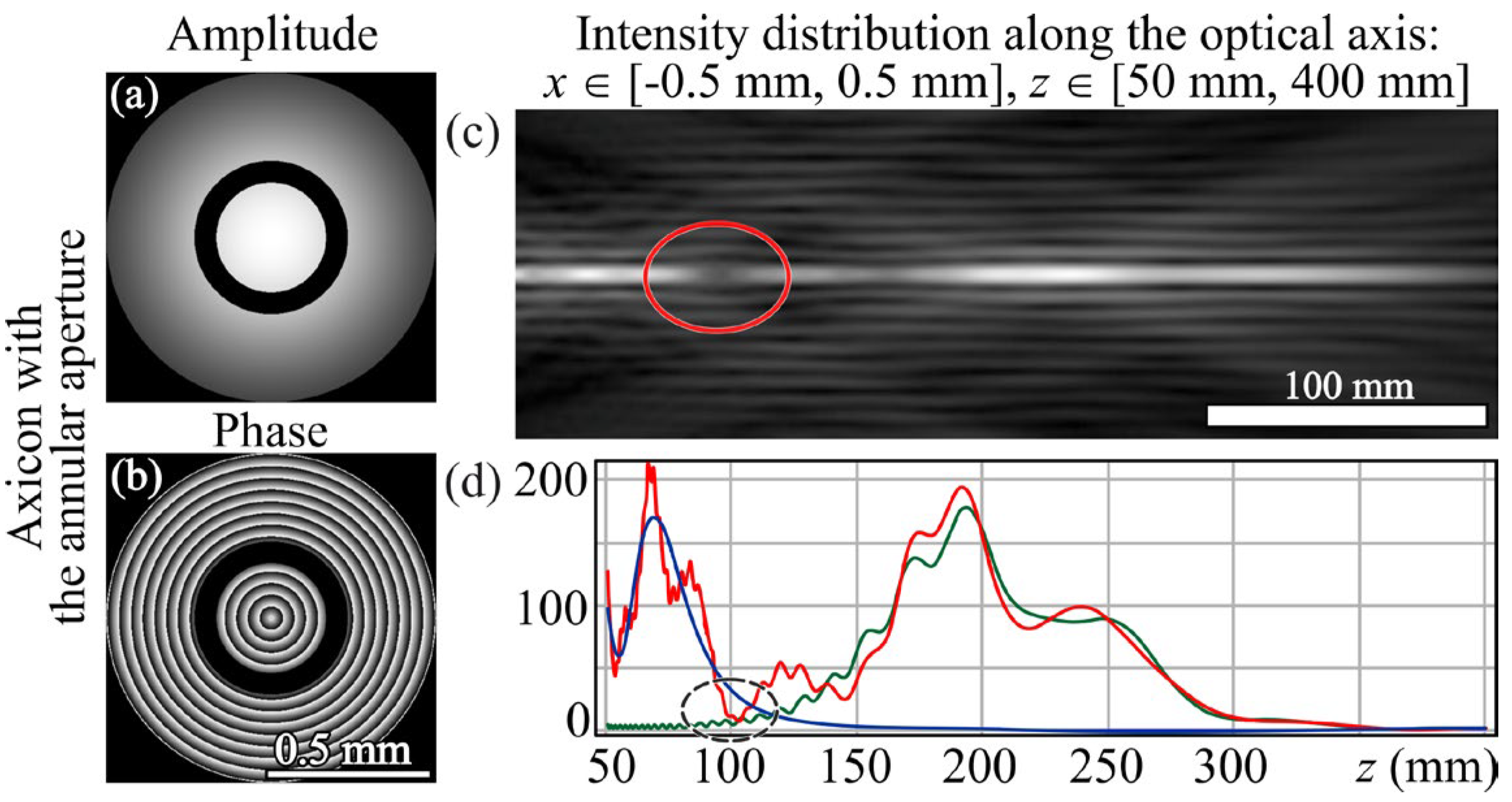
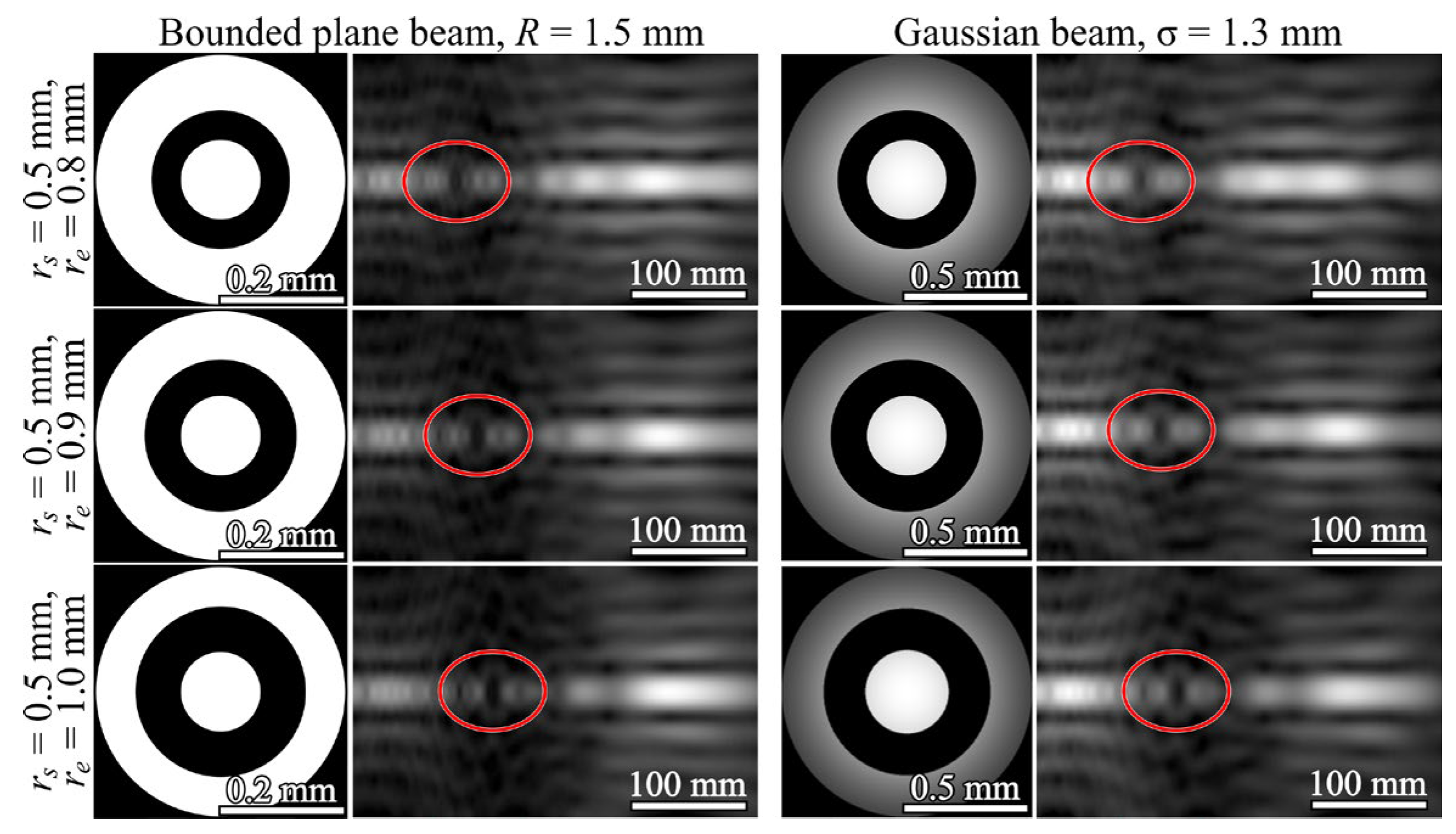
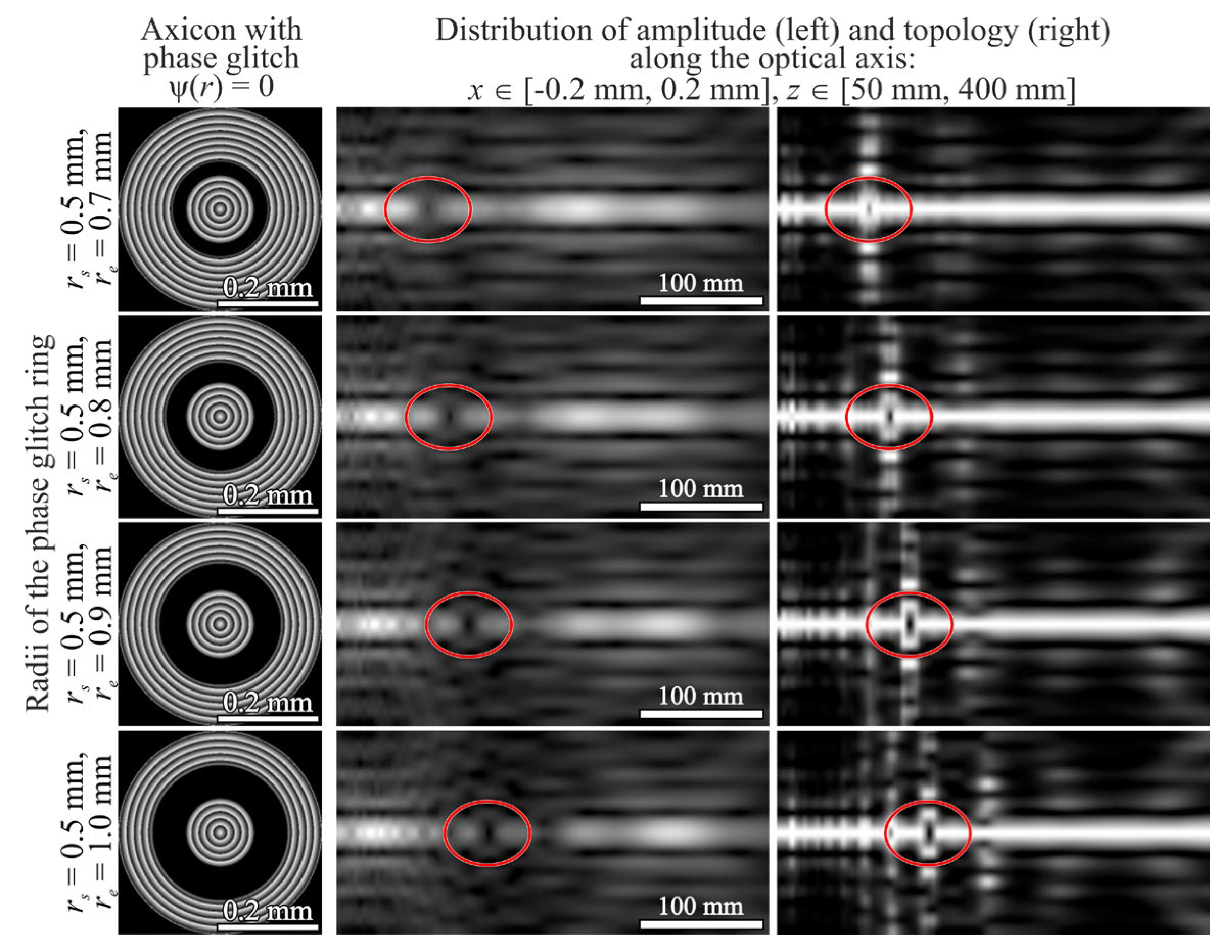
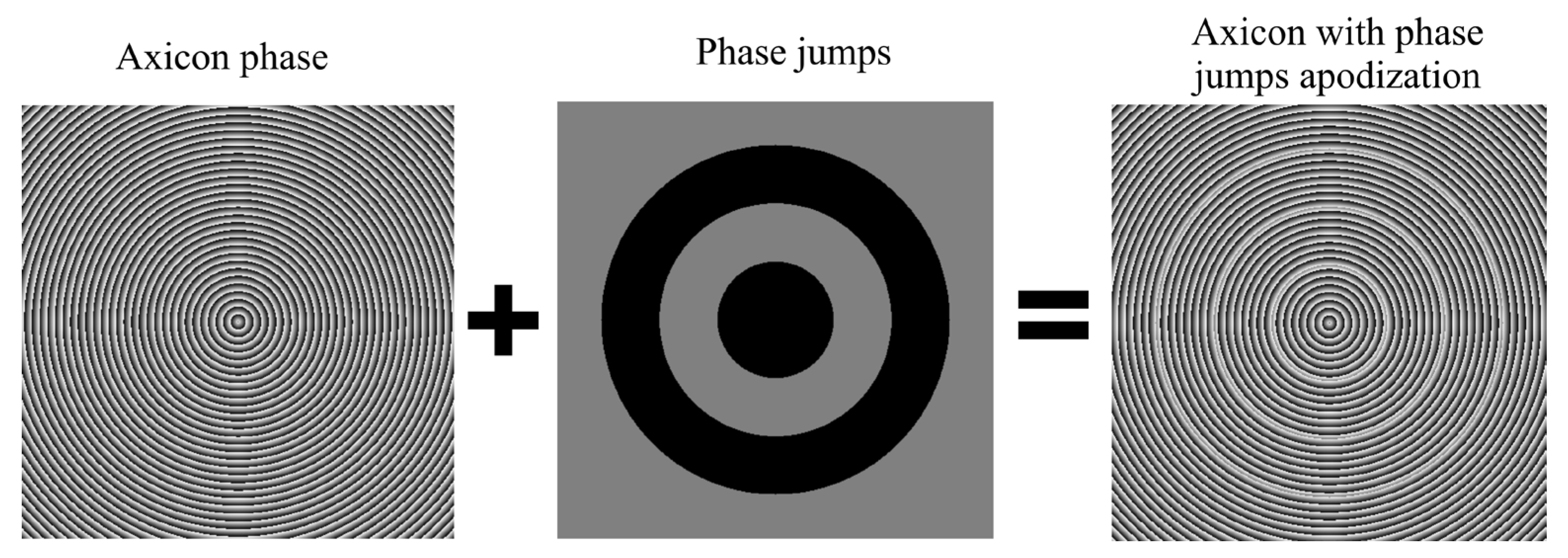

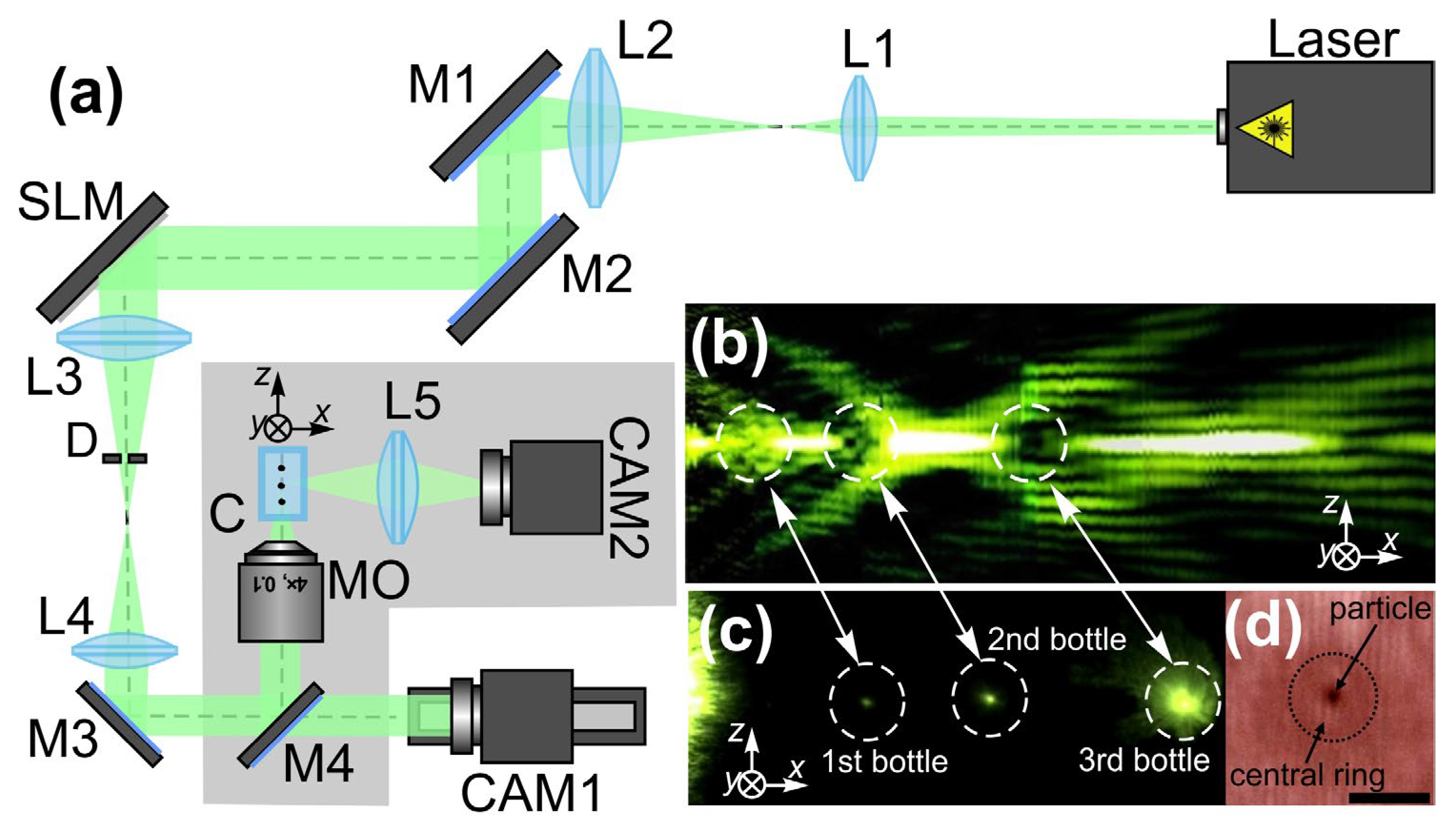
Disclaimer/Publisher’s Note: The statements, opinions and data contained in all publications are solely those of the individual author(s) and contributor(s) and not of MDPI and/or the editor(s). MDPI and/or the editor(s) disclaim responsibility for any injury to people or property resulting from any ideas, methods, instructions or products referred to in the content. |
© 2023 by the authors. Licensee MDPI, Basel, Switzerland. This article is an open access article distributed under the terms and conditions of the Creative Commons Attribution (CC BY) license (https://creativecommons.org/licenses/by/4.0/).
Share and Cite
Khonina, S.N.; Ustinov, A.V.; Kharitonov, S.I.; Fomchenkov, S.A.; Porfirev, A.P. Optical Bottle Shaping Using Axicons with Amplitude or Phase Apodization. Photonics 2023, 10, 200. https://doi.org/10.3390/photonics10020200
Khonina SN, Ustinov AV, Kharitonov SI, Fomchenkov SA, Porfirev AP. Optical Bottle Shaping Using Axicons with Amplitude or Phase Apodization. Photonics. 2023; 10(2):200. https://doi.org/10.3390/photonics10020200
Chicago/Turabian StyleKhonina, Svetlana N., Andrey V. Ustinov, Sergey I. Kharitonov, Sergey A. Fomchenkov, and Alexey P. Porfirev. 2023. "Optical Bottle Shaping Using Axicons with Amplitude or Phase Apodization" Photonics 10, no. 2: 200. https://doi.org/10.3390/photonics10020200
APA StyleKhonina, S. N., Ustinov, A. V., Kharitonov, S. I., Fomchenkov, S. A., & Porfirev, A. P. (2023). Optical Bottle Shaping Using Axicons with Amplitude or Phase Apodization. Photonics, 10(2), 200. https://doi.org/10.3390/photonics10020200





